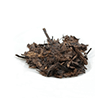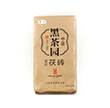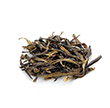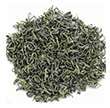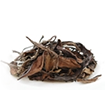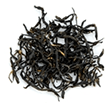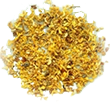About Black Tea (Known As Red Tea In China)
- Oxidization: Light to strong oxidization
- Growing Regions: Szechuan, Yunnan, Fujian, Guangdong
- Best Seasons To Purchase: Spring, Autumn
- Pharmacological Elements: Selenium, vitamins C, E, A, B, flavonoid compounds, tannic acid, potassium, carotene

Until the invention of Black Tea in the mid 17th century (Late Ming/Early Qing Dynasty), the majority of tea consumed in China for 2,500 years had been green un-oxidized and later, semi-oxidized teas. The story is that a passing army entered Fujian Province from Jianxi and camped at a tea factory in the Wuyi Mountain area. This held up tea production at the factory and after the army left, the leaves produced a tea with an unusual red colour. To recoup the losses from this delay, a farmer looked for a way to accelerate the drying time and save his order. Since the army used all the charcoal in the area which was usually used for drying green tea, he placed the leaves over a smoking fire of pine wood which caused a chemical reaction in the leaves and imparted a distinct smoky and fruity (Long An) flavor to the tea. Lapsang Souchong was born and led the way for the development of a whole family of teas which became very popular in China and a staple in the West - and helped to shape modern history in the process.
There are hundreds of different teas in the Black Tea family and each one is the result of a unique process of exposing picked leaves to air, heat and moisture to facilitate oxidization of the leaves. Like Lapsang Souchong, some are exposed to smoking which imparts an additional complexity of flavor to the tea.
As with any organic material, exposure to these elements stimulates a natural enzymatic breakdown of the leaf cell structure. This chemical breakdown creates new elements such as theaflavins and other elements which were not in the original tea leaves. These oxidization processes which were carefully guarded secrets were perfected over centuries and each process gives a tea its unique aroma and flavor.
A Quick History of Chinese Black Tea

Chinese Black Tea as it is called today in the West is the name given those teas that have been oxidized and the tea has a distinct red colour. This does not include the semi-oxidized and post-fermented teas which produce green and black coloured teas respectively. In China, these so-called “Black Teas” are actually known as Red Tea (Hong Cha) because of the reddish colour of the brew.
True Black Chinese Teas as they are known in China are the post-fermented (aged) teas of which the Pu-Erh family of teas is the most famous. These teas are a type of fermented tea that is aged like vintage wine, continuing the fermentation process over time (post-fermentation). Paradoxically, Pu-erh tea comes in green and black varieties! For more information, see Pu-erh Teas.
The confusion in naming came about in the 17th century when Dutch and British traders noticed that the leaves were darker than the usual un-oxidized green varieties consumed throughout China. The first mention of tea in European literature was in the book “Sea Voyage”, written by Lamu Soar, a Venetian.
When the British who traded in Xiamen City in Fujian province were first introduced to Black Tea , they thought they had found the proverbial pot of gold at the end of the rainbow. Here was a tea which had a taste they liked much better than green tea, could be shipped for long distances without spoiling and actually improved with age. And the label of “Black Tea” has stuck in the West ever since.
But history continues the confusion. Today, the vast majority of tea consumed in the West is from India. Unlike in China where all tea comes from the Camellia sinensis plant species, Indian tea is made from the native Camellia assamica species which has a higher (and more economical) yield, a stronger flavor and much higher levels of caffeine. Modern favourites like Darjeeling, Earl Gray and Orange Pekoe were developed by early British growers in India trying to inexpensively reproduce their favourite beverage from China.
Up to this time, the British preferred to pay the Chinese for their tea with the opium they cultivated from India. This became the cause of many wars and disputes between the two countries. So popular was Black Tea in Britain that the British Government had to stem the flow of their silver reserves to China. As the Dutch monopolized the tea trade and other countries continued to pay for tea in silver, the English found the lucrative Chinese tea markets closing to them. This problem was solved in 1848 when Robert Fortune, a Scottish botanist successfully smuggled tea plants and Chinese tea experts to India to develop technologies and oversee production to optimize the profits from Black Tea. After many failed attempts, Camellia sinensis was able to grow there but eventually, production of the native Camellia assamica plant was found to be far more lucrative .

In 1874, W.S. Lyle invented the first leaf rolling machine and in 1876, George Reid invented a cutting machine that stripped the leaves from the stems and cut them into short, thin strips. Unlike the carefully hand-picked teas from China, this mechanized “broken tea” was much more economical to produce and ship. From these beginnings, Broken Black Tea from India became a low-cost, high-profit commodity which helped fuel the British Empire of the 18th and 19th centuries and today has become a global beverage staple.
With the resurgence of the Chinese economy and growth of the Chinese tea industry worldwide, discerning tea drinkers around the world are re-discovering the New World of Chinese “Black Tea” flavours which provide the highest quality, depth and complexity of flavour made possible from whole leaves.
For the beginning of this story, see A Quick History Of Green Tea
Flavours of Chinese Black Tea
To learn about the flavours of Black Tea, see Flavour Guide
Storing Chinese Black Tea
Black Tea can be stored for long periods and improves with age. Also, caffeine levels tend to diminish naturally over time. We recommend a porcelain or glass container placed on a shelf, preferably not in the kitchen. The more airtight the container the better, as tea easily absorbs odours.
Chinese Black Tea And Health Benefits

There are many health benefits attributed to drinking Chinese tea, ranging from feelings of well-being to near magical cures. For the average Westerner, much of this interest is focused on ancient claims related to weight loss and more modern claims of cancer-prevention due to tea's anti-oxidant properties. Each person must make their own assessment of the facts. While there are centuries of tradition and empirical evidence from Traditional Chinese Medicine, there is little modern scientific consensus that supports the health benefits of tea. Even the effect of anti-oxidants to prevent anything has recently been drawn sharply into focus.
We believe that any food product can have positive and/or negative health effects and in varying degrees for different individuals. We do not recommend teas on the basis of health benefits and at this point, do not think it is prudent to recommend tea-drinking for anything other than to enjoy the wonderful flavour and the experience of enjoying tea alone or with friends.
For reference purposes only, we list some of the benefits of Chinese Black Tea as commonly recognized in Traditional Chinese Medicine:
- Reduce fat, protein and low-density “bad” cholesterol
- Rich in fluoride, promotes dental health
- Reduce fatigue, stimulating the central nervous system
- Promotes strong bones
- Enhance blood vessel elasticity and strength
Caffeine
It is common to hear people say “Tea has much more caffeine than coffee”. It is just as common to hear the opposite point of view. In fact with all the varieties of teas and coffees available, the different methods of manufacturing and preparing them for consumption and the different amounts consumed, both statements are in need of significant qualification.
So how much caffeine does tea and coffee have? Scientific studies and consumer group reports can both be less than detailed about what teas were used in their research. We will refer to a well detailed study published by the British Government (Survey of Caffeine Levels in Hot Beverages, Food Standards Agency, UK, August 2004):
- All Teas: mean 40 mg per serving
- Instant Coffee: mean 54 mg per serving
- Ground Coffee: mean 105 mg per serving
It has been generally believed that Chinese Green Tea has less caffeine than Black Tea. There is much study and discussion on this subject which suggests that his may not be the case. In fact Green Tea may have more caffeine than Black Tea. The confusion has been the result of more broad and unqualified statements that compare apples to oranges and not apples to apples, so to speak.
Most Black Tea exported to the West is from India and the Camellia assamica plant from which Indian tea is made produces higher levels of caffeine than from the Camellia sinensis variety that is used for Chinese teas. Furthermore, the oxidization process used in making Chinese Black Teas appears to reduce caffeine content rather than increase it as previously thought. So when you compare Chinese Green Tea to Chinese Black Tea, caffeine content in Chinese Green Teas seems to be higher than in Chinese Black Teas. Both are less than Indian Black Teas and all teas are significantly less than coffee.
(Note: We use the term “Chinese Black Tea ”as it is commonly used in the West to describe what are actually known in China as Red Teas. The true Chinese Black Teas as they are known in China are the post-fermented, aged teas such as Pu-Erh Tea).

But there is a way to reduce the caffeine level of any tea if you are sensitive to it. Any tea is best made using the traditional Chinese method of tea-making known as Gong Fu Cha (Tea With Great Skill). This highly controlled method of tea-making is characterized by using small teapots and multiple brews with very short steeping times of just a few seconds. This intensifies the flavour of any tea and reduces the caffeine consumed compared to Western methods of tea-making. In Gong Fu Cha, the first brew is for washing the leaves and is poured away, so it is not consumed. This also has the effect of washing away much of the caffeine which is highly soluble in water.
To learn about tea-making using the traditional Chinese Gong Fu Cha (Tea With Great Skill) technique, read our guide Gong Fu Cha - The Complete Guide To Making Chinese Tea by Daniel Lui.
 Top of Page
Top of Page

Ask The Tea Wizard
Don't know which tea is right for you? Answer a few questions and the Online Wizard will show you all the Chinese teas that suit your taste.


